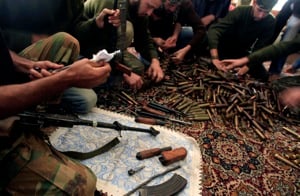WASHINGTON - The White House said Thursday that U.S. intelligence agencies now believe, with “varying degrees of confidence,” that the Syrian government used chemical weapons, but it said it needed conclusive proof before President Barack Obama would take action.
As recently as Tuesday, when an Israeli general added to the growing chorus that Syrian President Bashar Assad had used chemical weapons, White House spokesman Jay Carney said the administration was continuing to monitor and investigate but had “not come to the conclusion that there has been that use.”
The disclosure, in letters to congressional leaders, takes the administration a step closer to acknowledging that Assad has crossed a red line established by Obama last summer, when he said the United States would take unspecified action against Syria if there were evidence that chemical weapons had been used in the civil war, which the United Nations estimates has killed 70,000 people.
The White House emphasized that, “given the stakes involved,” the United States still needed “credible and corroborated facts” before deciding on a course of action. The letter, signed by the president’s director of legislative affairs, Miguel Rodriguez, said the United States was pressing for a “comprehensive United Nations investigation that can credibly evaluate the evidence and establish what happened.”
A U.S. official speaking on condition of anonymity said intelligence agencies have had indications of chemical-weapons use since March and reached the conclusions made public Thursday about two weeks ago.
Although the White House said it could not confirm the circumstances in which victims were exposed to chemical weapons, it said it believed that the chemical agent sarin had been used. “We do believe,” the letter said, “that any use of chemical weapons in Syria would very likely have originated with the Assad regime.”
Sarin is an odorless nerve agent that can be used as a gas or a liquid, poisoning people when they breathe it, absorb it through their skin or eyes, or take it in through food or water. In large doses, sarin can cause convulsions, paralysis and death. According to the Centers for Disease Control and Prevention, people usually recover from small doses, which may cause confusion, drooling, excessive sweating and nausea.
The White House said the current intelligence assessments of sarin use are based in part on “physiological samples.” U.S. officials said that could include human tissue, blood or other body materials, in addition to soil samples.
The White House described the attacks as “small scale,” but the full extent of the chemical-weapons use and resulting casualties was not immediately known.
Britain, in a letter last month requesting a U.N. investigation, cited three episodes in which it suspected that chemical weapons had been used: in a village west of Aleppo and on the outskirts of Damascus, both on March 19, and in Homs on Dec. 24.
Secretary of State John Kerry, emerging from a congressional hearing, said the United States believed that chemical weapons had been used in two instances, though he did not offer details.
Defense Secretary Chuck Hagel, wrapping up week-long travels in the Middle East that included daily discussions of the Syria crisis, said he was prepared to “give advice on policy decisions” for Pentagon action, but he cautioned that much remained uncertain about the purported use of chemical weapons by the Syrian regime.
The disclosure brought a swift reaction on Capitol Hill, where Sen. John McCain, R-Ariz., said, “I think it’s pretty obvious that a red line has been crossed,” and he referred to Obama’s characterization last summer that Syria’s use of such weapons would be a “game changer.”
McCain called on the president to begin supplying weapons to the rebels, which he has so far refused to do; to enforce a no-fly zone over Syria; and to redouble pressure on Russia to abandon its support for the Assad regime.
Obama has limited U.S. assistance to nonlethal aid, including military-style equipment such as body armor and night-vision goggles.
U.S. commanders have laid out a range of possible options for military involvement in Syria, including establishing a no-fly zone or secured area within Syria where citizens could be protected, launching airstrikes by drones and fighter jets, or even sending in tens of thousands of ground forces to secure the chemical-weapons caches. But the military has made it clear that any action would likely be either with NATO backing or with a coalition of nations similar to what was done in Libya in 2011.
Ahmad Ramadan, a member of the Syrian National Coalition opposition group’s executive body, called the U.S. assertion an “important step,” and he said that America had a “moral duty” to follow it with action.
Sen. Bob Corker of Tennessee, the ranking Republican member of the Senate Foreign Relations Committee, said the intelligence assessment was“deeply troubling,” and, if correct, meant that “President Obama’s red line has certainly been crossed.”
The administration’s use of the phrase “varying degrees of confidence” suggested that there might be differing levels of certainty among the U.S. intelligence agencies about the reliability of the evidence that chemical weapons were used.
The U.S. said the completion of a stalled U.N. investigation would be critical in confirming the use. But it’s unclear whether U.N. inspectors will ever be able to conduct a full investigation in areas where there is the most evidence of chemical-weapons use.
The Syrian government has so far refused to allow the U.N. experts to visit Khan al-Assal, where Assad’s government maintains the rebels used the deadly agents.
Officials said the U.S. was consulting with allies and looking for other ways to confirm the intelligence assessments.
In the latest developments in Syria, after five weeks of battle, Syrian government troops captured a strategic town near Damascus, cutting an arms route for rebels trying to topple Assad’s regime, state media and activists said Thursday.
By taking the town of Otaybah, east of the capital, the army dealt a major setback to opposition forces that in recent months have made gains near the city they eventually hope to storm.
The regime has largely kept the rebels at bay in Damascus, although opposition fighters control several suburbs of the capital from which they have threatened the heart of the city, the seat of Assad’s power. Last month, government troops began a campaign to repel the opposition’s advances near the capital, deploying elite army units to the rebellious suburbs and pounding rebel positions with airstrikes.
The director of the Britain-based Syrian Observatory for Human Rights, Rami Abdul-Rahman, said government troops regained control of Otaybah late Wednesday.
The state-run SANA news agency said Thursday that the army has “restored complete control” over Otaybah. The official news services also said Assad’s troops “discovered a number of tunnels that were used by terrorists to move and transfer weapons and ammunitions.”
The regime and state media refer to rebels as terrorists and accuse them of being part of a foreign plot seeking to destroy Syria.
On Thursday, the army was already capitalizing on the territorial gains, pounding southern suburbs of Damascus, including the long-contested Daraya with artillery barrages and airstrikes, according to the Syrian Observatory for Human Rights. The group, which relies on a network of activists inside the country, also reported fierce clashes between rebels and army troops to the east of the capital.
In Hama, rebels ambushed and destroyed an army vehicle after a six-hour battle with troops. Amateur videos uploaded by activists online showed an army vehicle in flames amid sounds of intense gun battles.
The fighting across the country has forced more than 1 million people to flee their homes and seek refuge abroad. Millions also have been displaced inside Syria.
International aid agencies have been pleading for funds to help refugees in neighboring countries such as Jordan and Lebanon. They have also been asking the Syrian government to allow aid convoys into the country and facilitate access to the area inside cities and towns that have been affected by fighting.
Information for this article was contributed by Mark Landler of The New York Times; and by Bradley Klapper, Julie Pace, Robert Burns, Lara Jakes, Kimberly Dozier, Lolita C. Baldor, Lauran Neergaard, Mohammad Hannon, Edith M. Lederer and Zeina Karam of The Associated Press.
Front Section, Pages 1 on 04/26/2013


